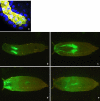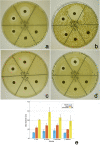An apocrine mechanism delivers a fully immunocompetent exocrine secretion
- PMID: 34354130
- PMCID: PMC8342421
- DOI: 10.1038/s41598-021-95309-8
An apocrine mechanism delivers a fully immunocompetent exocrine secretion
Abstract
Apocrine secretion is a recently discovered widespread non-canonical and non-vesicular secretory mechanism whose regulation and purpose is only partly defined. Here, we demonstrate that apocrine secretion in the prepupal salivary glands (SGs) of Drosophila provides the sole source of immune-competent and defense-response proteins to the exuvial fluid that lies between the metamorphosing pupae and its pupal case. Genetic ablation of its delivery from the prepupal SGs to the exuvial fluid decreases the survival of pupae to microbial challenges, and the isolated apocrine secretion has strong antimicrobial effects in "agar-plate" tests. Thus, apocrine secretion provides an essential first line of defense against exogenously born infection and represents a highly specialized cellular mechanism for delivering components of innate immunity at the interface between an organism and its external environment.
© 2021. The Author(s).
Conflict of interest statement
The authors declare no competing interests.
Figures




References
-
- Harder, J. J. Glandula nova lachrymalis una cum ductu excretorio in cervis et damis. Acta Eruditorum Lipsiae, 49–52 (1694).
-
- Purkinje JE. Beobachtungen der spiralen Schweisscanäle der menschlichen Epidermis. Amtl. Bericht über die Vers. deutcher Naturf. u Arzte zu Breslau. 1833;11:59.
-
- Schiefferdecker P. Die Hautdrüsen des Menschen und der Säugetiere, ihre biologische und rassenanatomische Bedeutung, sowie die Muscularis sexualis. Zoologica (Stuttgart) 1922;72:1–154.
-
- Fraenkel G, Brookes VJ. The process by which the puparia of many species of flies become fixed to a substrate. Biol. Bull. Mar. Lab. Woods Hole. 1953;105:442–449. doi: 10.2307/1538461. - DOI
Publication types
MeSH terms
Substances
Grants and funding
LinkOut - more resources
Full Text Sources
Molecular Biology Databases

